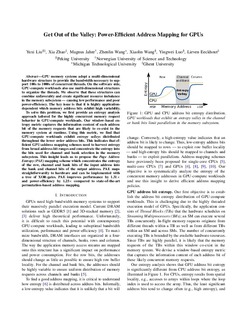| dc.contributor.author | Yuxi, Liu | |
| dc.contributor.author | Zhao, Xia | |
| dc.contributor.author | Jahre, Magnus | |
| dc.contributor.author | Wang, Zhenlin | |
| dc.contributor.author | Wang, Xiaolin | |
| dc.contributor.author | Lou, Yingwei | |
| dc.contributor.author | Eeckhout, Lieven | |
| dc.date.accessioned | 2019-01-30T13:58:21Z | |
| dc.date.available | 2019-01-30T13:58:21Z | |
| dc.date.created | 2018-11-05T20:14:27Z | |
| dc.date.issued | 2018 | |
| dc.identifier.issn | 2575-713X | |
| dc.identifier.uri | http://hdl.handle.net/11250/2583165 | |
| dc.description.abstract | GPU memory systems adopt a multi-dimensional hardware structure to provide the bandwidth necessary to support 100s to 1000s of concurrent threads. On the software side, GPU-compute workloads also use multi-dimensional structures to organize the threads. We observe that these structures can combine unfavorably and create significant resource imbalance in the memory subsystem - causing low performance and poor power-efficiency. The key issue is that it is highly application-dependent which memory address bits exhibit high variability. To solve this problem, we first provide an entropy analysis approach tailored for the highly concurrent memory request behavior in GPU-compute workloads. Our window-based entropy metric captures the information content of each address bit of the memory requests that are likely to co-exist in the memory system at runtime. Using this metric, we find that GPU-compute workloads exhibit entropy valleys distributed throughout the lower order address bits. This indicates that efficient GPU-address mapping schemes need to harvest entropy from broad address-bit ranges and concentrate the entropy into the bits used for channel and bank selection in the memory subsystem. This insight leads us to propose the Page Address Entropy (PAE) mapping scheme which concentrates the entropy of the row, channel and bank bits of the input address into the bank and channel bits of the output address. PAE maps straightforwardly to hardware and can be implemented with a tree of XOR-gates. PAE improves performance by 1.31X and power-efficiency by 1.25X compared to state-of-the-art permutation-based address mapping. | nb_NO |
| dc.language.iso | eng | nb_NO |
| dc.publisher | Institute of Electrical and Electronics Engineers (IEEE) | nb_NO |
| dc.title | Get Out of the Valley: Power-Efficient Address Mapping for GPUs | nb_NO |
| dc.title.alternative | Get Out of the Valley: Power-Efficient Address Mapping for GPUs | nb_NO |
| dc.type | Journal article | nb_NO |
| dc.type | Peer reviewed | nb_NO |
| dc.description.version | acceptedVersion | nb_NO |
| dc.source.journal | International Symposium on Computer Architecture | nb_NO |
| dc.identifier.doi | 10.1109/ISCA.2018.00024 | |
| dc.identifier.cristin | 1627236 | |
| dc.description.localcode | © 2018 IEEE. Personal use of this material is permitted. Permission from IEEE must be obtained for all other uses, in any current or future media, including reprinting/republishing this material for advertising or promotional purposes, creating new collective works, for resale or redistribution to servers or lists, or reuse of any copyrighted component of this work in other works. | nb_NO |
| cristin.unitcode | 194,63,10,0 | |
| cristin.unitname | Institutt for datateknologi og informatikk | |
| cristin.ispublished | true | |
| cristin.fulltext | postprint | |
| cristin.qualitycode | 1 | |
